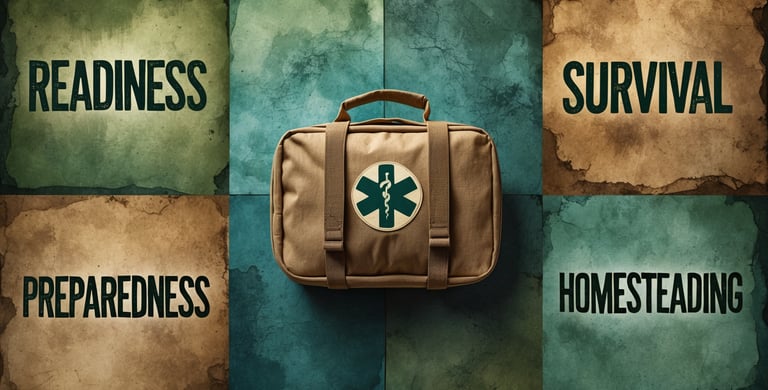Preparedness: Medical Preparedness
Supplies, Sanitation, and Chronic Care in Grid-Down Scenarios
4FORTITUDER - READINESS, SURVIVAL, PREPAREDNESS, HOMESTEADING
Preparedness: Medical Preparedness
Supplies, Sanitation, and Chronic Care in Grid-Down Scenarios
“He who treats the wound today avoids burying the body tomorrow.”
— 4FORTITUDE Survival Maxims
Health Becomes the Frontline When Systems Collapse
In a world without hospitals, pharmacies, or functioning infrastructure, the smallest cut becomes a gateway to infection, the common cold a test of immune endurance, and a chronic condition a looming battlefield.
Medical preparedness isn’t about pretending to be a doctor. It’s about taking full command of prehospital care, stabilizing the wounded, managing the ill, and maintaining health long enough to recover, escape, or rebuild.
It is the art of protecting flesh, breath, and blood when no one is coming—and becoming the reason someone else gets to survive.
Core Knowledge Foundation: The Four Medical Realities in Collapse
First-Line Trauma Response – Immediate care for wounds, bleeding, fractures, and burns.
Sanitation and Infection Control – Preventative hygiene in a non-sterile world.
Chronic Care and Maintenance – Managing diabetes, hypertension, asthma, and ongoing needs.
Field Pharmacy and Herbal Interventions – When the shelves are empty, your knowledge must remain full.
Misconception Warning: A full med kit without skills is false security. It’s not what you own—it’s what you know and can do under pressure.
1. First-Line Trauma Response – Seconds Matter
What to Have:
Tourniquet (CAT Gen7 or SOF-T): Arterial bleed control
Israeli Bandage: Pressure dressing
Chest Seal: For sucking chest wounds
SAM Splint: Fracture stabilization
Gloves, tape, gauze, shears, trauma scissors
How to Use It:
Run the MARCH protocol:
M – Massive bleeding
A – Airway
R – Respiration
C – Circulation
H – Head-to-toe check
Drill: Perform a solo 5-minute trauma simulation: Tourniquet, pressure bandage, splint, full verbal walk-through. Repeat monthly. Repetition = reflex.
2. Sanitation and Infection Control
Why It Matters: In collapse, most deaths are from infection, not violence. Disease spreads fast through contaminated water, poor hand hygiene, and improper wound care.
Core Gear:
Bar soap, alcohol, vinegar, hydrogen peroxide
Bleach (unscented) for surface and water sanitation
N95 masks, nitrile gloves
Plastic sheeting and duct tape for containment
Waste Management:
Dig latrines 200ft from water sources
Cover waste after each use
Create ash bucket for deodorizing and bacterial kill-off
Drill: Go 48 hours with no running water. Maintain hygiene using only your stored supplies. Track handwashing, waste, surface disinfection.
3. Chronic Care and Maintenance
Hidden Danger: Grid-down turns manageable conditions into life-threatening crises.
What to Do:
Inventory Every Medication
Track expiration dates
Store 3–6 month backup if possible
Use “vacation override” strategy for prescription refill surplus
Monitor Without Tech:
Use manual blood pressure cuff
Understand pulse + breath rates
Learn low-tech glucose monitoring strategies (urine strips, symptom logs)
Plan for Interruption:
Taper plans (if insulin or meds run out)
Alternative strategies (herbal support, food-based management)
Drill: Choose one chronic risk in your family. Build a 30-day backup plan (meds, food, tracking). Simulate a 3-day outage with no access to refills or online support.
4. Field Pharmacy and Herbal Interventions
When shelves are bare, you must reach into knowledge, not cabinets.
Basic Field Stockpile:
Acetaminophen + ibuprofen
Benadryl (antihistamine)
Loperamide (anti-diarrheal)
Triple antibiotic ointment
Aspirin (cardiac emergency standby)
Activated charcoal (food poisoning)
Herbal Allies:
Garlic: Antibacterial, antiviral, antifungal
Yarrow: Stops bleeding, prevents infection
Elderberry: Immune modulator
Peppermint: Digestive + anti-nausea
Valerian or passionflower: Sleep and stress support
Drill: Identify 5 local wild medicinals. Dry and prepare one tincture, poultice, or tea. Keep a field medicine guide in your survival binder.
Advanced Insights: Medical Leadership in Collapse
You don’t need an MD to lead. You need calm, confidence, and capability.
Historical Anchor: Sarajevo Siege (1992–1996)
Ordinary citizens became medics. Kitchen tables became clinics. The prepared didn’t just survive—they kept their communities alive when hospitals were shelled and medicine scarce. Knowledge became currency.
Your responsibility isn’t just to survive. It’s to become the first responder when no one else can be.
Critical Perspectives: Overmedicalization vs. Prepared Action
Adversarial Viewpoint:
“You can’t treat real medical issues without hospitals. Preparing for this is dangerous overreach.”
Response:
Tell that to the rural homesteader, the combat medic, or the missionary in a remote village. Survival medicine isn’t about being a doctor—it’s about being the reason someone lives long enough to see one.
Wisdom and Warning Duality
When Followed: You control infection. You keep wounds clean. You extend time. You stabilize life.
When Ignored: You watch a loved one suffer from a wound that could’ve been bandaged, a fever that could’ve been broken, or a breath that could’ve been restored.
Strategic Crossroad: Will you build your med readiness quietly now—or loudly grieve when it’s too late?
Final Charge & Implementation
Brother, medicine in collapse is about moral courage as much as tactical skill. You are the medic now. The healer. The stabilizer. The steward of breath and blood. And if you don’t prepare to save them—no one will.
Start Now:
Build the 4-Tier Med Preparedness Kit
“Every home is a clinic in waiting—if the man is ready.”
Trauma gear (bleeds, breaks, burns)
Hygiene and sanitation (wipes, soap, bleach)
OTC meds and prescriptions
Herbal support and guides
Establish Your Monthly Med Check Ritual
“A man who waits until the wound appears is already behind.”
Inspect med kit for expiration
Refill prescriptions, rotate OTCs
Run one simulation (burn, wound, infection)
Teach one skill to spouse or child
Strategic Reflection:
If your wife or child was bleeding, choking, or feverish—would your hands know what to do?
Existential Challenge:
If the hospitals stayed closed for 6 months, would your home be a place of healing—or helplessness?
Be the reason pain ends. Be the hands that bind, stabilize, and preserve. You may never wear a white coat—but you can be the man whose readiness writes survival into the story.
“Preparedness is not paranoia—it is protection made flesh.”


